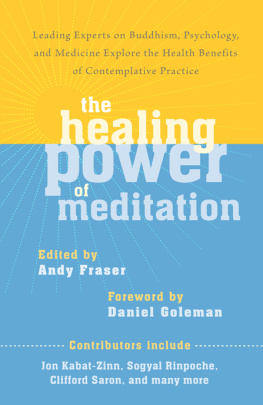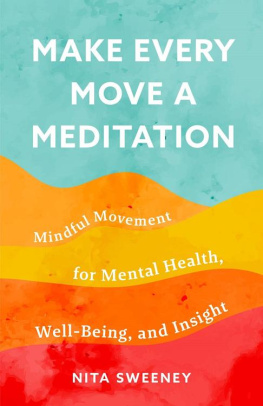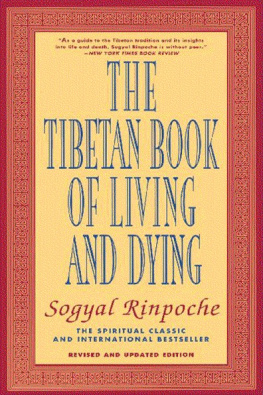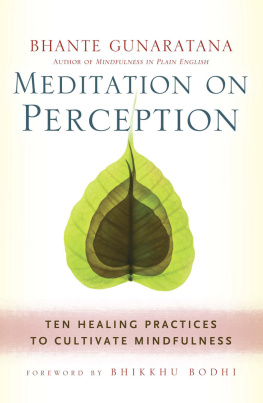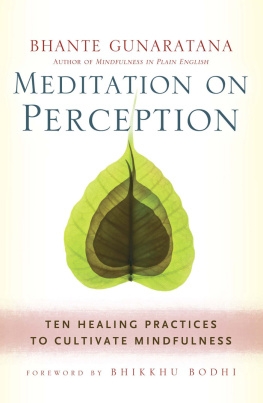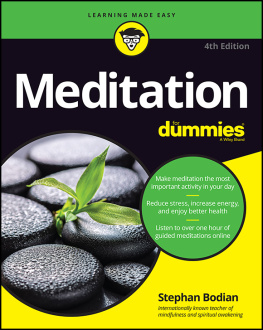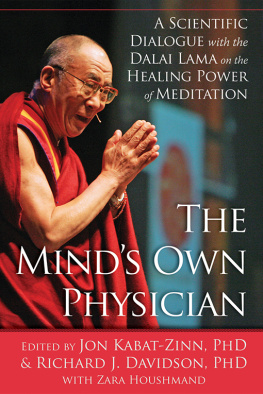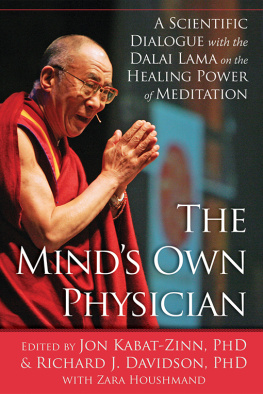ABOUT THE BOOK
Regular meditation practice can change the structure of the brain, wiring into us all kinds of benefits: improved concentration, contentment, resilience, better mental health, and more empathy and compassion. This wide-ranging anthology brings together leading Tibetan Buddhist teachers with researchers and health professionals to offer Buddhist perspectives on the mind, new studies, and first-hand accounts of how meditation is being applied in health and social care today.
- Sogyal Rinpoche and Jetsn Khandro Rinpoche on how meditation unlocks the minds healing power
- Dr. Jon Kabat-Zinn on the benefits of mindfulness in mainstream health care
- Dr. Clifford Saron on the Shamatha Project, the most comprehensive study of the effects of meditation ever conducted
- Dr. Sara Lazar on what happens to our brain when we meditate
- Dr. Erika Rosenberg on how meditation helps us relate better to our emotions
- Dr. Lucio Bizzini on how Mindfulness-Based Cognitive Therapy is used to treat depression
- Ursula Bates on how mindfulness supports terminally ill patients as they approach the end of their lives
Plus chapters from other innovators who apply meditation in health care and social work: Dr. Edel Maex, Dr. Cathy Blanc, Rosamund Oliver, and Dr. Frdric Rosenfeld.
ANDREW FRASER is a London-based writer and editor with a specialist interest in meditation and Buddhism. After graduating from Cambridge University, he trained as a journalist and worked for the BBC, covering major sporting events, including the 2012 Olympic Games. He has been practicing Tibetan Buddhism since 2002, and he regularly attends retreats at Lerab Ling in France. A prolific writer, Andrew is also the editor of View, The Rigpa Journal, an annual magazine on meditation and Tibetan Buddhism, which was founded in 2007.
Sign up to learn more about our books and receive special offers from Shambhala Publications.

Or visit us online to sign up at shambhala.com/eshambhala.
The Healing Power of Meditation
Leading Experts on Buddhism, Psychology, and Medicine Explore the Health Benefits of Contemplative Practice
Edited by Andy Fraser

SHAMBHALA
Boston & London
2013
Shambhala Publications, Inc.
Horticultural Hall
300 Massachusetts Avenue
Boston, Massachusetts 02115
www.shambhala.com
2013 by The Tertn Sogyal Trust
Some parts of chapter 10, by Ursula Bates, originally appeared in Trish Bartley, Mindfulness-Based Cognitive Therapy for Cancer: Gently Turning Towards (Chichester, UK: Wiley-Blackwell, 2011), 289302.
Cover design by Jim Zaccaria.
All rights reserved. No part of this book may be reproduced in any form or by any means, electronic or mechanical, including photocopying, recording, or by any information storage and retrieval system, without permission in writing from the publisher.
Library of Congress Cataloging-in-Publication Data
The healing power of meditation: leading experts on Buddhism, psychology, and medicine explore the health benefits of contemplative practice/edited by Andy Fraser.First edition.
Pages cm
Includes bibliographical references and index.
eISBN 978-0-8348-2893-3
ISBN 978-1-61180-059-3 (pbk.: alk. paper)
1. MeditationTherapeutic use. 2. MeditationBuddhism. 3. BuddhismPsychology. I. Fraser, Andy, 1973
RC489.M43H43 2013
615.8528dc23
2012050297
Contents
Sogyal Rinpoche
Jetsn Khandro Rinpoche
Dr. Frdric Rosenfeld
Clifford Saron, PhD
Erika Rosenberg, PhD
Sara Lazar, PhD
Jon Kabat-Zinn, PhD
Dr. Edel Maex
Dr. Lucio Bizzini
Ursula Bates
Dr. Cathy Blanc
Rosamund Oliver
Deepest thanks and appreciation go to the following people for helping to make this book a reality:
To all of the contributors for sharing their wisdom, expertise, and unique perspectives on the subject of meditation and healthand for their patience and assistance in preparing their chapters for publication.
To everyone at Rigpa International and Lerab Ling in France who was involved in organizing the conference that inspired this book, including Judith Soussans and Jan Linehan, Ally Cassidy, Cline Demarcq, Volker Dencks, Andy Fitzgibbon, Mylne Ghiglione, Eszter Hoffman, Anthony Morrey, Indira Rosenthal, Vinciane Rycroft, Sam Truscott, and Yessica Younes; and to Laurence Bibas and Olivier Raurich for facilitating the presentations.
To Patrick Gaffney, Philip Philippou, and Kimberly Poppe for their wise counsel, and all those who assisted with editing, translation, and transcribing, including Nancy Adess, Franois Audtat, Karien Bezemer, Simone Blatti, Helen Cargill, Tim Carstairs, Mary Deeks, Thomas Demarcq, Helen Depret, Linda Forrester, Phoebe Frame, Winie Froeling, Elizabeth Fukushima, Anahita Hamidi, Kathy Hammer, Ian Ives, Norman Jackson, Amy Jennings, Gela Krug, Karen Lane, Sylvie Marleau, Aline Maurer, Julie Milstien, Marian ODwyer, Paula Overgoor, Tineke Peeters, Julia Pruy, Sbastien Reggiany, Indira Rosenthal, Janet Savin, Isabella Schlenz, Linda Selis, Erric Solomon, Marlou van Hoorn, Marieke van Vugt, Christine Westlake, and Stephanie Wimmer-Davidson.
by Daniel Goleman, PhD
In the mid-1970s in Cambridge, Massachusetts, some of the seeds were planted that would bear such splendid fruit four decades later at Lerab Ling, a meditation center in the south of France. At Harvard, Richard Davidson and I, with the help of Clifford Saron, were doing research on attention training and on meditation as an intervention in stress reactivity. In the mid-1970s these topics were not yet on the map of mainstream psychology, and our work was not received with much enthusiasm.
Nearby, a recent PhD from MIT, Jon Kabat-Zinn, was beginning his program in Mindfulness-Based Stress Reduction for patients with chronic medical conditions, a then-new approach to helping people manage long-term illnesses in a way that would improve their quality of life. His work, too, was greeted with skepticism. Yet we all shared an underlying conviction that these applications of contemplative practice had great validity and could be of benefit to many, if given a chance. Our certainty stemmed in large part from our own experiences in Buddhist practice. In those days empirical evidence was sparse.
Slowly, over the years, those convictions have been borne out by scientific findings that strongly support the notion that our states of mind have an impact on our health, and on how we relate to the bodys inevitable failings. And meditation has proved to be one of the most powerful paths to managing our emotions in ways conducive to well-being.
We have come a long way since our early forays into this field, as the 2010 Meditation and Health congress at Lerab Ling attests. Like the conference itself, this book brings together leading experts from diverse backgrounds and specialtiesBuddhism, neuroscience, and medicineto explore from different angles how meditation can be most beneficial. Some of the major researchers in this areaClifford Saron, Sara Lazar, Jon Kabat-Zinn, and Erika Rosenberg among themreport their remarkable findings. On the Buddhist side, Sogyal Rinpoche, whose vision came to fruition with this conference, and Khandro Rinpoche offer a traditional context and a foundation for these beneficial practices.
This book not only includes some of the latest scientific research and charts the history of how meditation became more mainstream but also offers much practical application. It features people explaining how they integrate meditation out in the world, sharing their experiences and advice, and gives moving examples of how meditation has touched people and brought widespread benefit. These stories are told in a fascinating variety of voices, hard to find elsewhere: Ursula Batess work in hospice care, Edel Maexs and Lucio Bizzinis endeavors in psychiatry, Cathy Blancs trainings for doctors and nurses, and Rosamund Olivers teaching meditation to prison officers and caregivers. This range will be inspiring for health-care professionalsor anyonewho might be looking to introduce meditation in their work, or simply to try it for themselves.
Next page
